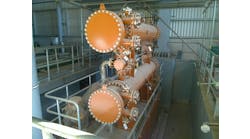I was staring at my electrician, barely listening to a conversation between him and a vendor about frequent problems with burned-out transmitter boards. It was an "aha" moment. I blurted out something about how we needed to ground the sensing transformer. Grounding eliminated all the problems with a series of nuclear level transmitters.
[pullquote]Most solutions in our business are more perspiration than inspiration. Gene Kranz of Apollo 13 fame called it "working the problem." So, let's consider how you do that.
Five approaches I've learned may help:
1. New/old. Ask questions like: What did we do differently? Has the material changed? Having a history with a process certainly makes it easier to identify variations between current and past practice. Make a list and proceed. Remember what Sherlock Holmes said: "When you have eliminated the possible, whatever remains, however improbable, must be the truth."
Finding the truth isn't enough, though — you still must substantiate it. If you claim a gasket material is unsuitable, don't be shocked when one stubborn gasket proves you wrong. Your next step is to explore how that gasket ruined your theory. Don't assume that conditions are the same. Even duplicate pumps in tandem wear differently. As always, don't over-generalize.
2. Inside/outside. Make a spreadsheet for this analysis. You're looking at a particular piece of equipment, say, a compressor, and examining how it interacts with the rest of the plant. If you can show that the outside, i.e., the piping and controls, isn't causing the problem, say, a pressure spike, then the culprit has to be inside — the compressor.
When I took vocational electronics in high school I learned a valuable lesson in troubleshooting: first check the power supply, then connections, and finally components. A similar approach applies to process engineering. Start by looking at the big picture, then work inward. So, if you have a problem with a steam jacket, first examine the steam supply, then the process piping and controls, and finally the jacket itself.
3. Timing is everything. Take care in defining the time frame for study. You want information based on steady-state operation or a carefully controlled bump. Be cautious when grabbing random trends.
4. Process understanding is invaluable. For instance, you will know that erosion, not a spike in reactor temperature, caused premature failure of an elbow. You may have to crunch numbers to put the model in your head but you will gain highly useful insight. Sometimes, a test can improve your understanding.
5. Know the lay of the land. Keep in mind how a plant is physically laid out. If multiple instruments fail in the same area at the same time, look for the common thread: the distributed control system (DCS). Board assignments often are based on plant geography.
Now, let's consider how to make the work easier. We've all been to training seminars where we're asked to write on a whiteboard all prospective solutions, no matter how ridiculous some may seem. Yes, do that. Then, consider some other tools.
A timeline showing relevant events always is a useful troubleshooting device. Don't crowd it too much with data! A DCS trend often will provide too much data — be selective! Use the timeline to remove coincidences and follow-on events that stemmed from the root cause or occurred at random. This elimination process is especially important for complex processes where a dozen minor issues may be crying to be solved.
Another useful implement is a cause-and-effect table. Consider "cause" categories such as: environment, design, change, operation, maintenance, installation, and manufacturing defect.
Look for systemic errors. Once, I identified an O-ring as the culprit for a leaking actuator — one of several identical units on the site. It turned out that an engineer had used process temperature, not actuator temperature, to choose the material. This brings up another point — always question design limits. These often are based on flimsy logic.
Sometimes it's impossible to know. Instruments aren't perfect. Pressure and temperature often measure local conditions — not bulk properties. Vibration switches are over-simplified to make them easier to interpret. Sometimes it's better to listen with your ears — noise nearly always is a sign of trouble. And, finally, if you still can't eliminate the potential causes, then make a list of changes that will ameliorate the damage and move on.
DIRK WILLARD is a Chemical Processing Contributing Editor. You can e-mail him at [email protected]


